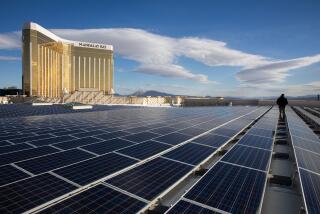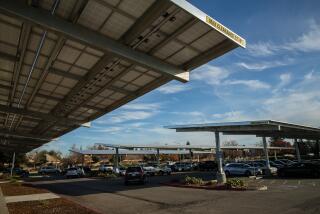Nothing new under the sun, whether solar power or ostrich farms
- Share via
Long before the age of Hollywood and Mickey’s Magic Kingdom, one of the hottest tourist draws in Southern California involved a herd of scowling ostriches and a towering, solar-powered engine.
The pairing may sound wacky, but at the turn of the 20th century, it kept the curious flocking to the San Gabriel Valley. According to Rick Thomas, author of “South Pasadena’s Ostrich Farm,” the attraction was the world’s first successful commercial use of a solar-powered motor.
First, the story of the ostriches: In 1886, businessman Edwin Cawston traveled to South Africa and acquired 50 ostriches with the goal of breeding them, Thomas said. At the time, ostrich feathers were a popular women’s fashion accessory, and Cawston hoped to cash in on the trend.
Cawston opened an ostrich farm in Norwalk, but after some 10 years, he moved to South Pasadena, which was enjoying boom in tourism and boasted the luxury Royal Raymond hotel. Cawston figured he was guaranteed a steady flow of patrons.
But even before Cawston opened his new farm, the Raymond hotel burned down on Easter Sunday, 1895. Although it would be six years before the hotel was rebuilt, Cawston forged ahead with his relocation plans. His farm became an instant hit. “At the time, it was the equivalent of Disneyland,” said Frank T. Kryza, author of “The Power of Light.”
Visitors could rides ostriches, watch the beasts eat oranges in a single gulp, view incubators and coo over downy chicks. Not surprisingly, the Cawston Ostrich Farm gift shop was packed with pricey ostrich paraphernalia, such as feathered muffs, boas, fans and hat plumes.
Yet it wasn’t until Cawston crossed paths with inventor-tinkerer Aubrey Eneas that he considered buying a solar-powered engine.
Born in England, Eneas immigrated to Boston in the 1880s, according to Kryza. He was enamored with the possibilities of solar power and spent 10 years perfecting a gigantic cone-shaped reflector to collect and focus sunlight.
“Solar power was going like gangbusters all over the U.S.,” said Kryza. “Many American inventors of this period were interested in using it as an alternative to expensive coal, especially in parts of the country where coal would have to be shipped long distances.”
Eneas realized the future of solar power lay in the West, where the sun shined nearly year-round. During a winter vacation to Pasadena, he visited the ostrich farm and met Cawston.
“The two hit it off immediately,” Kryza said. “They were both promoters and would have made great used-car salesmen.”
Cawston convinced Eneas to move to California (Eneas later set up his business, the Solar Motor Company, in downtown Los Angeles) and Eneas convinced Cawston to buy one of his machines for about $2,500.
Cawston wanted the motor so he could pump water onto his property. In the age before aqueducts, the area was “dry as a bone,” said Kryza.
Eneas installed the six-story high apparatus on a sunny hillside in 1901. The device, which resembled a radar dish, was 33 feet in diameter at its widest point and lined with 1,788 mirrors. The mirrors funneled the sun’s rays onto a boiler containing 1,000 gallons of water. The resulting steam was used to power an engine that pumped between 1,400 and 1,500 gallons of water a minute from a deep well on the farm. The dish was attached to a track on a supporting tower so it could be kept trained on the sun.
The monstrous magnifier only heightened the farm’s exotic quality. “No extra charge to see the Solar Motor!,” declared printed handbills. “The only machine of its kind in the world in daily operation! 15-horsepower engine worked by the heat of the sun!”
Most tourists grasped the charm of a newly hatched chick or an orange-gobbling ostrich, but the solar motor left many perplexed. “The science involved was way above the average person,” said Kryza. “Tour guides had to explain that there was no connection between the solar device and the ostriches, and that the high temperatures produced had nothing to do with the incubation of eggs.”
Those in the know, however, were impressed with the “sun motor’s” capabilities. Reporters from local papers and national scientific journals descended on the farm. A 1901 article in Engineering News praised the “perfection of the apparatus,” while another writer predicted a grand future for solar power. “If the sun motor will pump water, it will also grind grain, saw lumber, and run electric cars,” the writer prophesied.
Sunlight, however, failed to beat out oil as the fuel of choice. And although Eneas installed a few more machines in California and Arizona, they proved vulnerable to wind and hailstorms. By 1910, Eneas had racked up $100,000 in debt, said Kryza. He declared bankruptcy and retired.
The Cawston Ostrich Farm solar motor, however, remained in use until the start of World War I, when it was taken apart and its steel parts were donated to the war effort, Kryza said. The farm continued to operate until 1934.
Today, one energy research and development company, Sandia National Laboratories, is currently running tests in the desert of solar-power dishes inspired by Eneas’ prototype at the ostrich farm. So in a sense, Eneas’ work lives on.
Now if only someone would bring back an ostrich farm.
More to Read
Sign up for Essential California
The most important California stories and recommendations in your inbox every morning.
You may occasionally receive promotional content from the Los Angeles Times.













